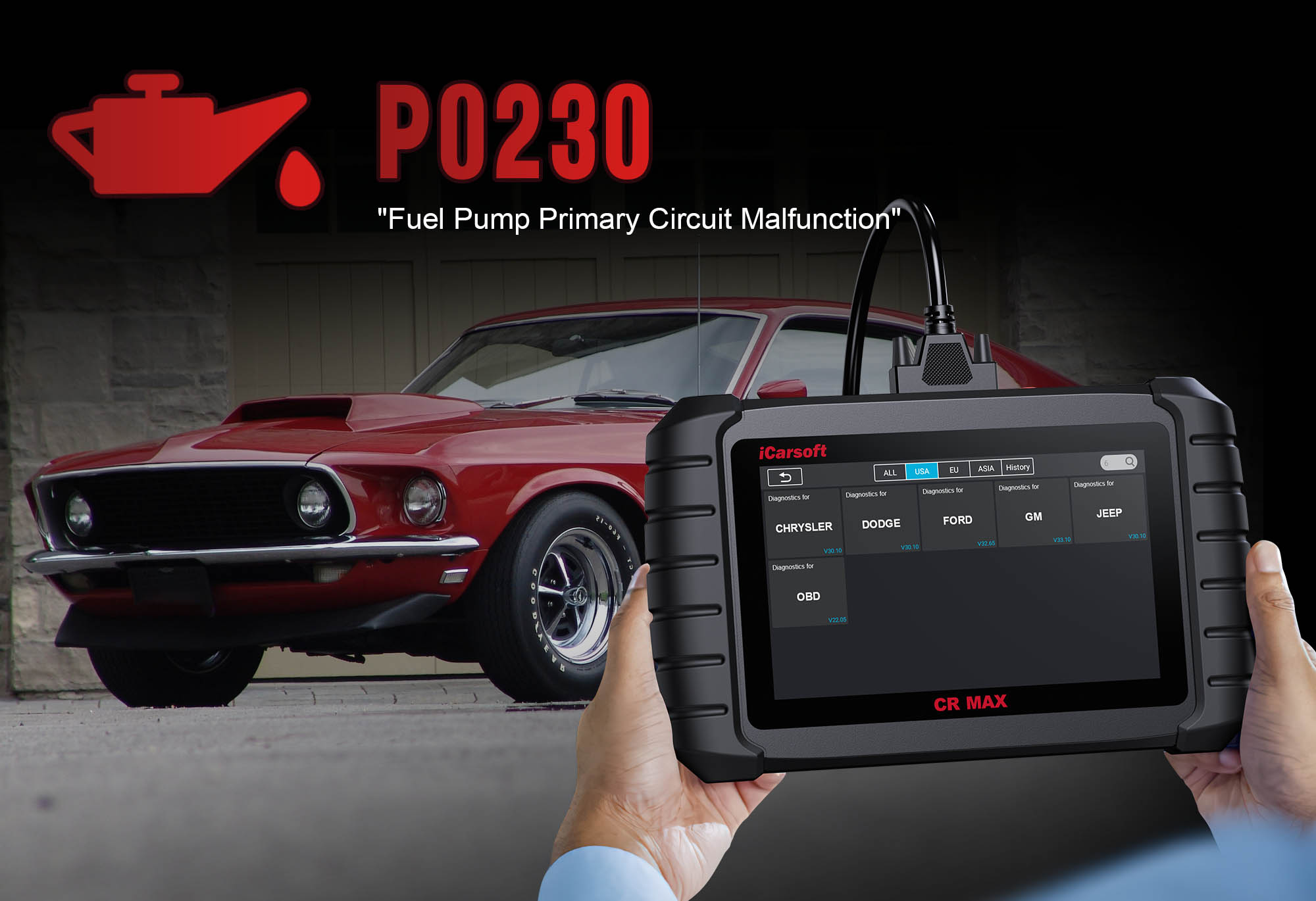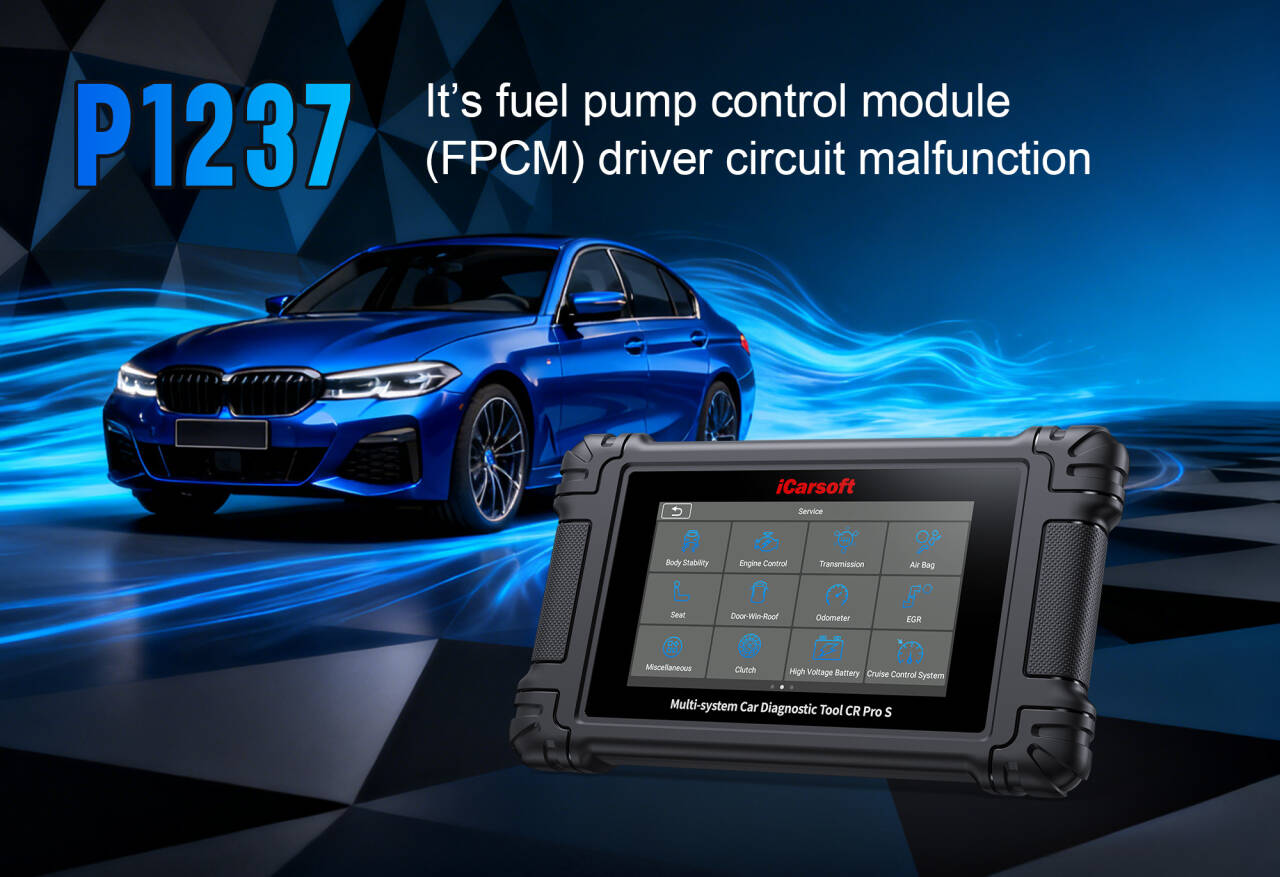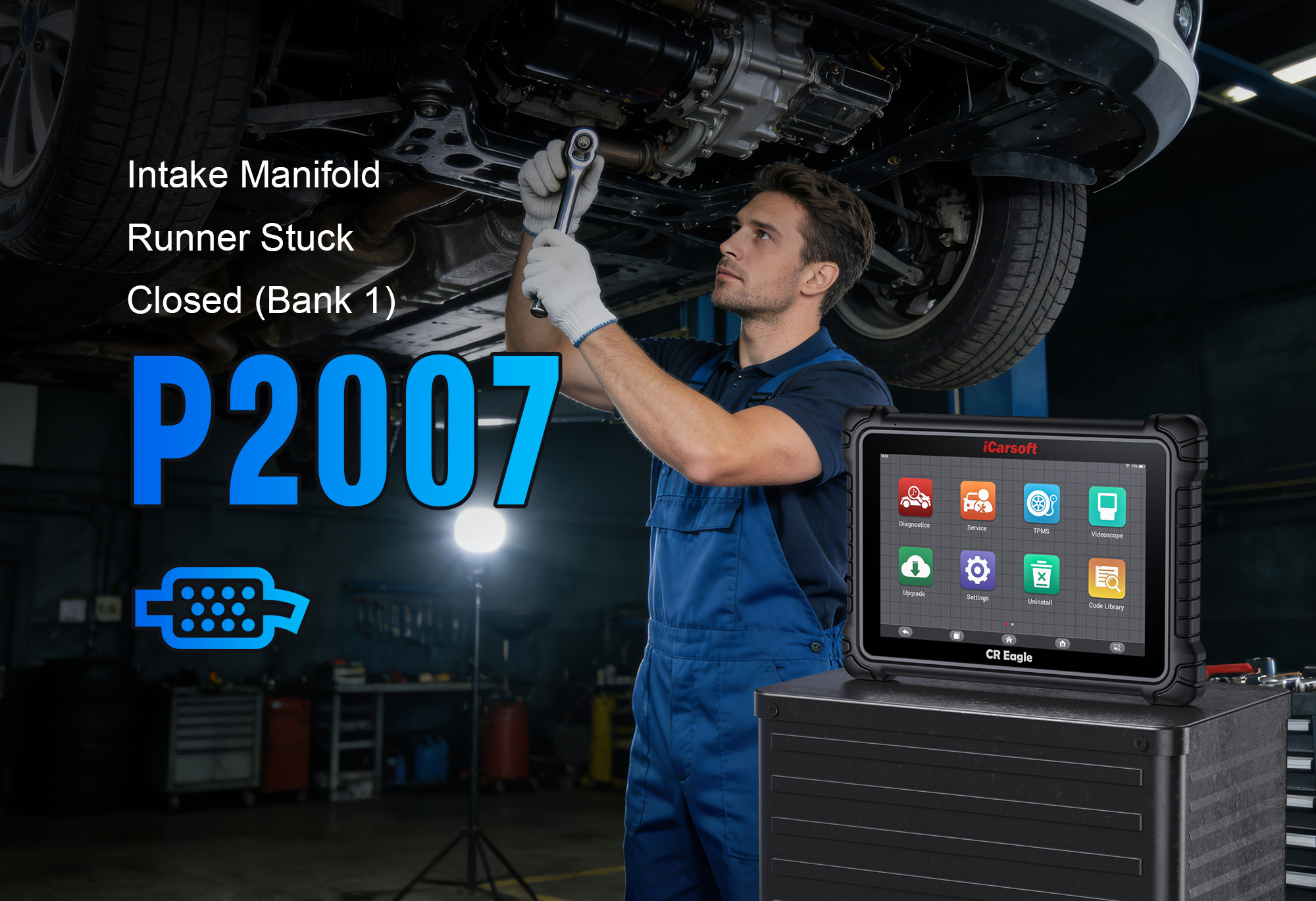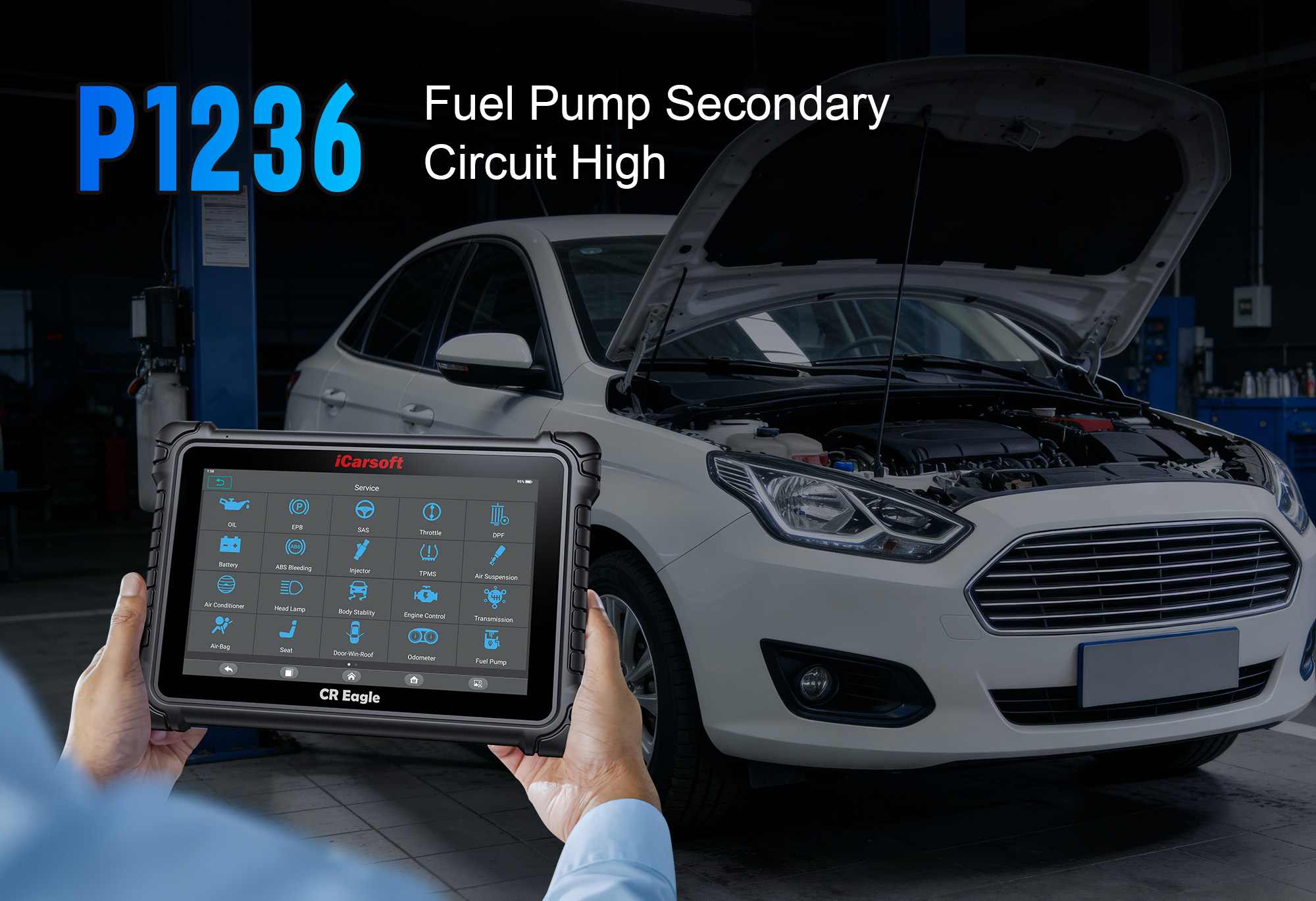P0230 Code: Fuel Pump Primary Circuit Issues – A Complete Guide to Diagnosis & Fixes
Turning the key to find a sputtering engine or silence is every driver’s frustration—and the P0230 code is often the hidden cause. This OBD-II trouble code signals a malfunction in your vehicle’s fuel pump primary circuit, the system that delivers critical power to the fuel pump. Ignore P0230, and you could face worsening performance, unexpected stalling, or even a car that won’t start. In this guide, we’ll break down what P0230 means, its top causes and symptoms, step-by-step diagnosis, and why the iCarsoft CR MAX is your most reliable tool for troubleshooting.
What Is the P0230 Code?
The P0230 code is a generic OBD-II diagnostic trouble code (DTC) defined as “Fuel Pump Primary Circuit Malfunction”. It triggers when your vehicle’s Engine Control Unit (ECU) detects abnormal voltage, current, or signal behavior in the primary circuit that powers the fuel pump.
To grasp why this matters, let’s break down the fuel pump system’s role:
-
The fuel pump (typically inside the fuel tank) pushes fuel from the tank to the engine at a precise pressure (25–60 psi, depending on the vehicle)—without it, the engine can’t receive the fuel it needs to run.
-
The primary circuit is the electrical pathway that supplies power to the fuel pump. It’s controlled by key components: a fuse (protects against overloads), a relay (acts as an on/off switch), and the ECU (regulates when power flows).
-
When the ECU detects a fault in this circuit—such as no power, a short circuit, or erratic current—it illuminates the Check Engine Light and stores P0230, warning you of a problem that could disable fuel delivery.
Crucially, P0230 focuses on electrical issues in the circuit, not just the fuel pump itself. This means the problem could be a simple blown fuse or faulty relay—not a costly pump replacement.
Common Causes of the P0230 Code
P0230 stems from electrical failures or component wear in the fuel pump system. Below are the most frequent culprits, ordered by how likely they are to cause the code:
Faulty Fuel Pump Relay
The relay is the “gatekeeper” of power to the fuel pump. Over time, its internal contacts wear out, corrode, or get stuck—preventing power from reaching the pump or sending erratic current. This is the single most common cause of P0230.
Damaged Wiring or Connectors
Wires in the fuel pump circuit fray, crack, or short out due to engine heat, vibration, or moisture (e.g., water leaks near the fuel tank). Corroded or loose connectors also disrupt power flow—common in older vehicles or those driven in harsh conditions.
Blown Fuel Pump Fuse
A dedicated fuse (usually 5–20A, labeled “FP” or “Fuel Pump”) protects the circuit from electrical overloads. A short circuit in the wiring or a failing fuel pump can blow this fuse, cutting power to the pump entirely.
Defective Fuel Pump
A failing fuel pump motor draws irregular current (too high or too low) as it wears out. The ECU detects this abnormal current and flags it as a circuit fault—often paired with symptoms like weak fuel pressure or a “whirring” pump sound.
ECU Malfunction (Rare)
In rare cases, a faulty ECU misinterprets normal circuit signals as “abnormal.” This is usually fixed with a manufacturer software update; full ECU replacement is only needed for severe hardware failures.
Symptoms of a P0230 Code
P0230 symptoms range from mild performance issues to complete fuel delivery failure. Watch for these warning signs to catch the problem early:
Illuminated Check Engine Light
The most obvious and consistent symptom— the light stays on until the circuit fault is repaired and the code is cleared.
Hard Starting or No Start
If the pump isn’t getting power, the engine struggles to turn over or won’t start at all. You may hear a weak “whirring” (failing pump) or silence (no power to the pump) when turning the key.
Poor Acceleration
The engine feels sluggish or unresponsive when you press the gas—insufficient fuel flow (from a weak pump or partial power loss) can’t keep up with the engine’s demand.
Intermittent Stalling
The engine shuts off unexpectedly, especially at low speeds or idle. This happens when a faulty relay or loose wire temporarily cuts power to the pump.
Intermittent Issues
Problems may come and go (e.g., the car starts fine one day, stalls the next). This “intermittent” behavior is common with loose wires or failing relays—and makes diagnosis nearly impossible without a tool like the CR MAX.
How to Diagnose the P0230 Code (with iCarsoft CR MAX)
Diagnosing P0230 requires a systematic approach: start with the simplest, cheapest components (fuses/relays) before moving to more complex ones (wiring/pump). The iCarsoft CR MAX streamlines this process with fuel system-specific tools—no guesswork required.
-
Read the Code & Check for Related Faults
-
Plug the CR MAX into your vehicle’s OBD-II port (under the dashboard), power it on, and select your make/model/year. Use AutoVIN Recognition to skip manual entry—this ensures you get vehicle-specific fuel pump circuit specs.
-
Navigate to Engine Control Module > Fault Codes > Read Codes to confirm P0230 is present.
-
Check for related codes (e.g., P0231 = “Fuel Pump Primary Circuit Low Voltage,” P0232 = “Fuel Pump Primary Circuit High Voltage”). These narrow down the fault: low voltage points to wiring/relay issues, while high voltage suggests a short circuit.
-
Inspect the Fuel Pump Fuse & Relay
Start here—fuses and relays are easy to test and replace, and they cause 60% of P0230 cases:
-
Locate Components: Use the CR MAX’s Component Location guide to find the fuel pump fuse (in the engine bay or interior fuse box) and relay (often in the same fuse box, labeled “FP” or “Fuel Pump”).
-
Test the Fuse: Remove the fuse and check for a broken filament. For certainty, use the CR MAX’s Multimeter > Continuity Test: touch the probe to each end of the fuse—a beep means it’s good; no beep = blown (replace with the same amperage fuse).
-
Test the Relay:
-
Quick Swap Test: Swap the fuel pump relay with an identical relay (e.g., A/C relay) of the same part number. If P0230 clears, the original relay is faulty.
-
CR MAX Relay Test: For deeper verification, use the CR MAX’s Special Functions > Relay Test. It sends power to the relay to check if it switches correctly—failed test = replace the relay.
-
Inspect Wiring & Connectors
If fuses and relays are good, damaged wiring is the next likely culprit:
-
Visual Inspection: Follow the wiring harness from the fuel pump relay to the fuel tank (use the CR MAX’s Wiring Diagram). Look for:
-
Frayed or cracked insulation (common near hot engine parts or sharp metal).
-
Corroded connectors (at the relay or fuel pump connector—white/green buildup means corrosion).
-
Loose terminals (wiggle connectors gently—if they move easily, they’re not secured).
-
Continuity Test (CR MAX):
-
Disconnect the fuel pump connector (under the vehicle or inside the tank—consult your owner’s manual).
-
Set the CR MAX to Multimeter > Continuity Test.
-
Connect one probe to the power wire at the relay connector, and the other to the power wire at the fuel pump connector—a beep means the wire is intact; no beep = broken wire (repair or replace).
-
Clean Connectors: Use electrical contact cleaner to remove corrosion from pins. Apply dielectric grease to prevent future moisture damage.
-
Test Fuel Pump Voltage & Function
Confirm if the pump is receiving power—and if it’s working properly:
-
Voltage Test (CR MAX):
-
Reconnect the fuel pump connector.
-
Set the CR MAX to Multimeter > DC Voltage Test.
-
Connect the positive probe to the pump’s power pin, and the negative probe to a metal ground (e.g., the vehicle’s frame).
-
Turn the key to “On” (don’t start the engine)—normal voltage is 11V–14V. No voltage = relay/wiring fault; low voltage (<10V) = weak battery or corroded ground.
-
Function Test: Listen for the fuel pump when turning the key to “On”—you should hear a 2–3 second “hum” (the pump priming). No sound = pump isn’t receiving power or is defective.
-
Fuel Pressure Test: For final confirmation, attach a fuel pressure gauge to the fuel rail (schrader valve). Start the engine—normal pressure is 25–60 psi (check the CR MAX’s Sensor Specs for your vehicle). Low pressure = failing fuel pump.
Pro Tip: If you don’t have a pressure gauge, use the CR MAX’s Live Data (under Engine > Fuel System). Many modern vehicles report “Fuel Rail Pressure” directly—irregular readings confirm a pump issue.
-
Rule Out ECU Issues (Last Resort)
If all other components check out, the ECU may be the problem—but this is rare:
-
Use the CR MAX to check for ECU Software Updates (under Special Functions > Vehicle Info > TSB Lookup). Outdated firmware often causes false P0230 codes and can be fixed with a free dealer update.
-
If updates don’t work, consult a professional technician. They’ll use specialized tools to test the ECU’s ability to send signals to the fuel pump circuit—full ECU replacement is only needed for severe hardware failures.
Fixing the P0230 Code
Once you’ve pinpointed the cause with the CR MAX, fixes are straightforward and targeted:
-
Replace Blown Fuse or Faulty Relay
-
Replace the fuel pump fuse with the exact same amperage (e.g., 15A—never use a higher amperage fuse, as it can damage wiring).
-
Install a new OEM-compatible fuel pump relay. Use the CR MAX’s Part Lookup feature to find the correct relay for your make/model.
-
Repair or Replace Damaged Wiring/Connectors
-
For frayed wires: Cut out the damaged section and splice in new wire (use heat-shrink tubing to seal the connection against moisture).
-
For corroded connectors: Replace the connector if pins are bent or broken. For minor corrosion, clean with electrical contact cleaner and apply dielectric grease.
-
Secure loose wiring with zip ties to prevent vibration damage.
-
Replace the Fuel Pump (If Defective)
If voltage is good but the pump is silent or pressure is low, follow these steps:
-
Safety First: Disconnect the negative battery cable and relieve fuel pressure (follow your vehicle’s manual—usually done by removing the fuel pump fuse and starting the engine until it stalls).
-
Access the Pump: Most vehicles require removing the fuel tank; some have a rear seat access panel (check the CR MAX’s Component Location guide).
-
Replace the Pump: Remove the old pump assembly, install a new OEM pump, and reconnect all connectors.
-
Prime the System: Turn the key to “On” (30 seconds) 2–3 times (don’t start) to build fuel pressure before starting the engine.
-
Reset the Code & Verify Repairs
-
Use the CR MAX to Clear Codes (under Fault Codes > Clear Codes)—this turns off the Check Engine Light.
-
Start the engine and let it idle for 5 minutes—check for smooth operation (no stalling or sputtering).
-
Take a 30-mile test drive (include highway acceleration and low-speed driving) with the CR MAX’s Data Logging enabled. Monitor fuel pump voltage and fuel pressure to ensure stability.
-
Re-scan after driving: No P0230 + consistent voltage/pressure = fix successful.
Why Choose the iCarsoft CR MAX for P0230 Troubleshooting?
Basic OBD scanners only tell you “P0230”—they can’t test relays, check wiring continuity, or monitor fuel pressure. The iCarsoft CR MAX solves this with fuel system-specific features that save you time and money:
Accurate Code & Related Fault Detection
Retrieves P0230 and linked codes (P0231/P0232) to narrow down the fault—no more guessing if it’s a voltage or wiring issue.
Built-In Multimeter & Relay Tests
Tests fuses, relays, and wiring continuity in one tool—no need to buy a separate multimeter or relay tester.
Live Data & Fuel Pressure Monitoring
Views real-time fuel pump voltage and fuel rail pressure—spots irregularities that cause intermittent P0230.
Vehicle-Specific Guides
Preloaded with fuel pump/relay locations, wiring diagrams, and pressure specs for 10,000+ models—never waste time searching for fuse box positions.
User-Friendly for Beginners
Intuitive touchscreen and step-by-step prompts make P0230 diagnosis simple—even if you’ve never worked on a fuel system before.
Final Thoughts
The P0230 code may seem intimidating, but it’s often a simple fix—like replacing a $10 relay or fuse. The key is systematic diagnosis: start with the cheapest, easiest components before moving to the fuel pump or ECU.
With the iCarsoft CR MAX, you skip the guesswork. Its multimeter, relay tests, live data, and vehicle-specific guides let you pinpoint the fault quickly—avoiding expensive shop visits or unnecessary parts replacements.
Remember: Safety is critical when working with fuel systems—always disconnect the battery, relieve fuel pressure, and work in a well-ventilated area. If you’re uncomfortable accessing the fuel tank or testing wiring, consult a professional mechanic—they’ll use the CR MAX’s data to confirm the issue in minutes.
With the right knowledge and tools, P0230 doesn’t have to leave you stranded. The iCarsoft CR MAX turns “car won’t start” into a manageable repair—getting you back on the road with confidence.





